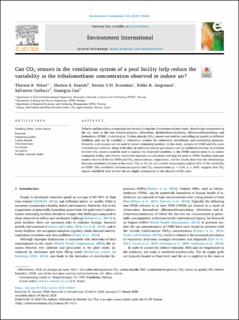| dc.contributor.author | Nitter, Therese Bergh | |
| dc.contributor.author | Grande, Morten S. | |
| dc.contributor.author | Svendsen, Kristin V Hirsch | |
| dc.contributor.author | Jørgensen, Rikke Bramming | |
| dc.contributor.author | Carlucci, Salvatore | |
| dc.contributor.author | Cao, Guangyu | |
| dc.date.accessioned | 2020-08-24T07:09:54Z | |
| dc.date.available | 2020-08-24T07:09:54Z | |
| dc.date.created | 2020-03-14T08:54:58Z | |
| dc.date.issued | 2020 | |
| dc.identifier.citation | Environment International. 2020, 138 (105665), . | en_US |
| dc.identifier.issn | 0160-4120 | |
| dc.identifier.uri | https://hdl.handle.net/11250/2673475 | |
| dc.description.abstract | Volatile and hazardous compounds are formed during the chlorination of pool water. Monitoring components in the air, such as the four trihalomethanes; chloroform, dichlorobromomethane, dibromochloromethane and bromoform (tTHM), is challenging. Carbon dioxide (CO2) sensors are used for controlling air quality in different buildings and can be installed in ventilation systems for continuous surveillance and monitoring purposes. However, such sensors are not used in indoor swimming facilities. In this study, samples of tTHM and CO2 were collected and analysed, along with other air and water quality parameters such as combined chlorine, to evaluate whether CO2 sensors could be used to explain the observed variability in the tTHM concentration in an indoor swimming facility and thereby reduce the exposure of individuals utilising the pool to tTHM. Random intercept models were built for the tTHM and CO2 concentrations, respectively, and the results show that the relationships between combined chlorine in the water, CO2 in the air and number of occupants explain 52% of the variability in tTHM. The correlation between occupancy and CO2 concentration (ρ = 0.65, p ≤ 0.01) suggests that CO2 sensors should be used so that the air supply corresponds to the demand of the users. | en_US |
| dc.language.iso | eng | en_US |
| dc.publisher | Elsevier | en_US |
| dc.rights | Navngivelse 4.0 Internasjonal | * |
| dc.rights.uri | http://creativecommons.org/licenses/by/4.0/deed.no | * |
| dc.title | Can CO2 sensors in the ventilation system of a pool facility help reduce the variability in the trihalomethane concentration observed in indoor air? | en_US |
| dc.type | Peer reviewed | en_US |
| dc.type | Journal article | en_US |
| dc.description.version | publishedVersion | en_US |
| dc.source.pagenumber | 7 | en_US |
| dc.source.volume | 138 | en_US |
| dc.source.journal | Environment International | en_US |
| dc.source.issue | 105665 | en_US |
| dc.identifier.doi | 10.1016/j.envint.2020.105665 | |
| dc.identifier.cristin | 1801654 | |
| dc.description.localcode | This is an open access article distributed under the terms of the Creative Commons CC-BY license, which permits unrestricted use, distribution, and reproduction in any medium, provided the original work is properly cited. | en_US |
| cristin.ispublished | true | |
| cristin.fulltext | original | |
| cristin.qualitycode | 1 | |

